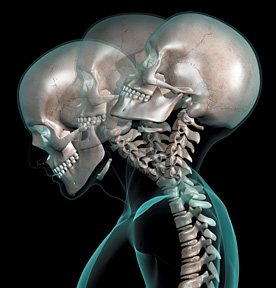Whiplash is the most common injury associated with motor vehicle
accidents, affecting up to 83 percent of those involved in collisions,
and is a common cause of chronic disability. The Quebec Task Force (QTF)
on Whiplash Associated Disorders defines whiplash as "bony or soft
tissue injuries" resulting "from rear-end or side impact, predominantly
in motor vehicle accidents, and from other mishaps" as a result of "an
acceleration-deceleration mechanism of energy transfer to the neck." It
is estimated that as many as four per 1,000 people may experience a
whiplash-related injury and associated pain syndromes. The overall
economic burden of whiplash injury, including medical care, disability
and sick leave, is estimated at a staggering $3.9 billion annually in
the U.S. alone.
The mechanism of injury suggests that whiplash may occur as a result
of hyperextension (excessive backward bending) of the lower cervical
spine (neck) in relation to a hyperflexion (excessive forward bending)
of the upper cervical vertebrae, producing a force of impact "whipping"
through the body. The result is soft-tissue damage, inflammation and
muscle spasm.

Whiplash is associated with a wide variety of clinical symptoms including
neck pain, neck stiffness, arm pain, jaw pain,
headaches
and paresthesias (tingling/numbness), problems with memory and
concentration, and psychological distress. Symptoms of whiplash may not
present until several weeks after the causative incident. Frequently
people experience little pain and discomfort in the early stages.
However, after several weeks the body begins to manifest symptoms. It is
this delayed onset of symptoms and lack of early treatment intervention
which may cause the condition to become chronic and debilitating.
Whiplash Prevention
While a whiplash injury may be unavoidable if you're involved in a
crash, there are simple but effective precautions you can take to
minimize the risk. As they say, an ounce of prevention is worth a pound
of cure.
Head restraint: If more than one person uses a car, it is
better to adjust the head restraint for each driver and make sure that
it's positioned according to the convenience of each driver. Not
adjusting the head restraint for each driver greatly increases the
likelihood of injury. The head restraint must be locked when driving. If
the head restraint is not locked, it may move during an accident,
taking away protective support when needed most and resulting in
substantial injuries to the neck.
Evidence suggests that being the driver increases the chances of head
injury by double and also shows that women suffer from whiplash
injuries more than men because they tend to sit more upright and closer
to the steering wheel. A study by Brian Stemper, PhD, assistant
professor of neurosurgery at the Medical College of Wisconsin in
Milwaukee, found: "Auto head restraints positioned less than 2.4 inches
(6 cm) from the back of the head kept ligament stretch within the
physiologic range - meaning that no injury would occur. However, as the
restraint distance increased beyond 2.4 inches, the ligaments began to
exceed failure thresholds, meaning that whiplash injury was more likely
to occur."
Seat belt: Although the seat belt in and of itself will not
prevent whiplash, it does help to prevent your body from lurching
completely forward during a car crash, even a low-impact crash. The
simple act of buckling up is responsible for approximately a 60 percent
reduction in accident fatalities. So buckle up to save your life and
protect your neck.
Neck exercises: Whiplash affects the neck muscles. The stronger the muscles, the less affected by sudden movement your neck will be. Engage in
neck exercises
to strengthen the soft tissues of the neck. Exercise won't prevent
whiplash, but it can make you less susceptible to the forcible forward
and backward neck jolts. Isometric resistance exercises for the neck are
easy to do and highly effective in strengthening the supportive
musculature of the neck. Your doctor can provide you with specific
neck-strengthening exercises.
Treatment Options
Whiplash injuries are difficult to treat for many reasons. Complex
interactions of psychosocial, legal and physical factors make effective
treatment highly variable. However, there are many therapeutic options
available to help whiplash related injuries. Initial treatment
traditionally includes a soft cervical collar to restrict cervical range
of motion and prevent further injury. Overall rest and motion
restriction may hinder progress in the long run, so it is best to seek
out professional help in resolving symptoms.
That's where your chiropractor comes in.
Chiropractic: Chiropractors are the single largest
group of practitioners treating whiplash injuries, and they do it well:
For example, one study found chiropractors were effective at relieving
whiplash pain more than 90 percent of the time. Chiropractic care
focuses on relieving soft- tissue spasm, inflammation and pain by
restoring proper motion in the spinal column. Due to the force impact of
whiplash, the spinal column can misalign and cause pain. By performing
manipulation to the spinal column, chiropractic can help restore normal
function and movement to the affected areas.
 In fact, the FDA has mandated that all acetaminophen-containing prescription products
feature a "black box" warning (the administration's strongest safety
statement) noting an overdose can cause liver failure and even death;
and have been urged to place similar language on OTC acetaminophen
products.
In fact, the FDA has mandated that all acetaminophen-containing prescription products
feature a "black box" warning (the administration's strongest safety
statement) noting an overdose can cause liver failure and even death;
and have been urged to place similar language on OTC acetaminophen
products.